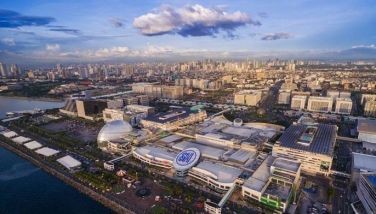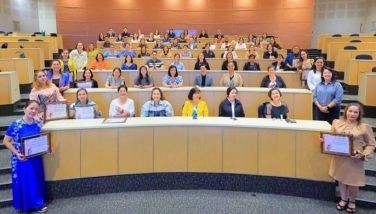The past on a pedestal
August 21, 2006 | 12:00am
Two events conspired last week to pull me back to corners of a past I either never personally knew or just stood at the margins of. One was largely pleasant, the other decidedly disturbing, but both were immensely educational, thought-provoking, and even moving.
The first was my completion – literally on the eve of my departure for a semester in the United States – of the technical editing of the 950-page text of the yet-untitled history of the University of the Philippines, which will mark its first 100 years in 2008. I say "technical" editing because the substantive work on the massive project – the research, the writing, and the preliminary editing – had already been completed by a team of selected UP writers headed by my colleague in the English Department, Dr. Helen Lopez, whose energy and discernment produced a document of impressive breadth, incisiveness, and panache.
As the project’s director and the book’s principal editor, Dr. Lopez – herself a former Secretary of the University – had to oversee the collection and organization of a century’s worth of information on our country’s best and biggest public university, and the transformation of those notes by her team of writers into a comprehensive but popularly accessible history. The centennial history itself had been the brainchild of then-President Francisco "Dodong" Nemenzo, who wanted something well researched but also readable and engaging. I came into the project as his Vice President for Public Affairs, tasked with reviewing and finetuning the finished draft.
As I entered my last few edits last Monday, I did so with a mixture of relief and regret, feeling greatly privileged to have been, in effect, this version’s first reader, and yet also saddened somewhat to realize that the book was effectively finished, and that the rest of the story had literally to be written by authors yet to come.
From my vantage point, however, I can tell you – if you’re in any way connected to or interested in UP – that this history will be an engrossing read, as much for its sheer nostalgia value as its chronicling of our intellectual life, from UP’s creation in 1908 by Act 1870 through to the Austin Craig affair, the Palma-Quezon tiff, the suspension of Jose Garcia Villa for his "coconut" poem, Jorge Bocobo’s Courtesy Appeals, the PGH at war, the transfer to Diliman, furtive flirtations at the Gregory Terrace, Dean Ursula Clemente’s "one-foot rule," the beautiful if bygone Cadena de Amor, the rise of the UPSCA and the Pascual-Delaney match-up, an English instructor named Jose Ma. Sison, the First Quarter Storm and the Diliman Commune, UP Los Baños’ abortive secession, UP’s growth into a system, socialized tuition, the Javier-Posadas confict, the Pahinungod volunteers, UP in cyberspace, and the Revised General Education Program. It also goes beyond Diliman and Padre Faura to report on the highs and lows of UP life in the Visayas, Baguio, and Mindanao.
I hope I won’t be revealing too much – not easy to do, when you have almost a thousand pages to go over – if I quote some passages at random just to suggest the flavor of the material.
(Of UP in the mid-1930s) "Quezon liked keeping in constant touch with the UP constituency, making an appearance at every invitation. The sight of him inspecting the campus while astride a white horse, which he would ride from Malacañang, was nothing unusual to the students. The hospitality was mutual, because Quezon would play host – cordial and even affectionate – to the UP constituency when they held picnics on the Malacañang grounds."
(Of Bienvenido Gonzalez, writing the Japanese wartime administration to release him from his post) "(I am ) begging leave to be permitted to retire from the presidency of UP… For the last 10 years my health has been maintained artificially by daily injection of insulin. With the absence of this drug in the market now, I am unable to obtain the regular treatment for the maintenance of my normal self and this is being reflected in my work.’"
(Of the transfer to Diliman in the early 1950s) "Three thousand students attended classes in Diliman, with one-third of them taking up residence there. The secondary streets that branched away from the main campus oval had military names like Infantry Ave., Artillery Ave., and Cavalry Ave. These threaded through the residential areas, which the US Army had simply designated with numbers; thus Areas 1, 2, 3, 6, 9, 14 and 17. The bigger Quonsets were designated as the Men’s Dormitories and the Women’s Dormitories. The first Women’s Dorm, formerly the nurses’ quarters standing on the site of the present-day Ilang-Ilang and International Houses, housed 200, with four girls assigned to a room. Bathrooms, although not tiled, were equipped with showers and flush toilets of the water-closet type. Because the female student population was bigger, more accommodations were provided for them. Later another Quonset was converted into a second Women’s Dorm, and these two dormitories were called, simply, the North Women’s Dorm and the South Women’s Dorm."
But mostly – and perhaps aptly – UP’s history has been one of struggle, both to survive as an institution of higher learning and to defend its much-vaunted academic freedom and secular character in the face of tremendous pressures from without and within. If the record seems scored and scarred by excessive intramurals, it can only be because these tempests in academia necessarily reflected and played out national and social issues on a smaller scale, often more intensely. Most edifying for me – as a former university administrator myself – was the realization that the same issues tend to erupt on campus over and over again, down the decades: fiscal autonomy, academic freedom, the role of religion in a secular institution, generating income, the UP President vis-à-vis (or versus) the Philippine President, idealism and pragmatism, elitism and democratization, nation and region, campus sex and other fun ways to banish the term-paper blues.
Plans will still be finalized for the UP history, but the administration is considering publishing two or even three editions of the book: the complete text, for reference purposes; an abridged, reader-friendly, generously illustrated coffee-table book edition for UP alumni; and, possibly, a short and simplified student edition in pocketbook form for the orientation packets of incoming freshmen.
It’ll take a while, but I have high hopes for the success of this UP Centennial project. If you were a Gregory Terrace, Grove, Rodic’s, Basement, or Lighthouse habitué, start saving up for your copy of this yearbook to end all yearbooks.
My other brush with history came a few days and 8,000 miles away, at the United States Holocaust Memorial Museum in Washington, DC. I’m a certified museophile, and have spent the equivalent of days at the Smithsonian, the British Museum, and wherever else people have put the past on a pedestal – in the case of the Holocaust Museum, a very low one, considering the sordidness and the brutality of much of the material and the evil impulses that created them. And yet here, in the lowest and darkest of habitations, it was the human spirit that survived and soared, and now preserved for the likes of us, who were never there, to encounter.
Postwar Filipinos tend to think of World War II as a series of action movies featuring tons of truly heavy metal – say, armies of Panzer tanks or swarms of V-2 rockets – and one or two mushroom clouds. We know precious little of the personal stories and tragedies that made up lives, and lives lost, in a bloodbath halfway around the world that seemed to have little to do with our own struggle against Imperial Japan. (And yet, as Manolo Quezon reminds us, it did – his grandfather President Quezon offered refuge in the Philippines to 10,000 Jews who might otherwise have been exterminated in Europe; and the Holocaust Museum recognizes this with a place-name for the Philippines on the global map of safe havens for prewar Jews.)
Although I had seen similar exhibits – the Imperial War Museum in London, Anne Frank’s house in Amsterdam, and the former Gestapo headquarters in Berlin all offer grimly moving artifacts of the Holocaust for the distant alien’s consideration – the Holocaust Museum presents them all of a piece, in a powerfully orchestrated performance that includes a floor-to-high-ceiling, wall-to-wall album of photographs of the citizens of an obliterated Lithuanian village. We keep hearing about the murder of six million Jews, but "six million" boggles the mind; a silent roomful of shoes – the actual shoes taken from hundreds of concentration-camp inmates, from boots to booties – vividly evokes their wearers.
Easily the most awful sight in the parade of atrocities were photographs – set in a pit, away from children’s eyes – of Nazi medical experiments, including vats full of dismembered human limbs. But above and beyond the horror rises indomitably human hope: in the poetry of the survivors, and, most poignantly, in the art that the inmates produced in the midst of so much death and despair: a garland of colored leather flowers, a brooch.
I emerged wondering if and when we would ever come out with a similar memorial to record exactly what happened during our martial law years – certainly no Holocaust, but traumatic enough to those who lived through it – which many Filipinos seem all too eager to forget, and some too willing to revive.
E-mail me at penmanila@yahoo.com and visit my blog at http://homepage.mac.com/jdalisay/blog/MyBlog.html
The first was my completion – literally on the eve of my departure for a semester in the United States – of the technical editing of the 950-page text of the yet-untitled history of the University of the Philippines, which will mark its first 100 years in 2008. I say "technical" editing because the substantive work on the massive project – the research, the writing, and the preliminary editing – had already been completed by a team of selected UP writers headed by my colleague in the English Department, Dr. Helen Lopez, whose energy and discernment produced a document of impressive breadth, incisiveness, and panache.
As the project’s director and the book’s principal editor, Dr. Lopez – herself a former Secretary of the University – had to oversee the collection and organization of a century’s worth of information on our country’s best and biggest public university, and the transformation of those notes by her team of writers into a comprehensive but popularly accessible history. The centennial history itself had been the brainchild of then-President Francisco "Dodong" Nemenzo, who wanted something well researched but also readable and engaging. I came into the project as his Vice President for Public Affairs, tasked with reviewing and finetuning the finished draft.
As I entered my last few edits last Monday, I did so with a mixture of relief and regret, feeling greatly privileged to have been, in effect, this version’s first reader, and yet also saddened somewhat to realize that the book was effectively finished, and that the rest of the story had literally to be written by authors yet to come.
From my vantage point, however, I can tell you – if you’re in any way connected to or interested in UP – that this history will be an engrossing read, as much for its sheer nostalgia value as its chronicling of our intellectual life, from UP’s creation in 1908 by Act 1870 through to the Austin Craig affair, the Palma-Quezon tiff, the suspension of Jose Garcia Villa for his "coconut" poem, Jorge Bocobo’s Courtesy Appeals, the PGH at war, the transfer to Diliman, furtive flirtations at the Gregory Terrace, Dean Ursula Clemente’s "one-foot rule," the beautiful if bygone Cadena de Amor, the rise of the UPSCA and the Pascual-Delaney match-up, an English instructor named Jose Ma. Sison, the First Quarter Storm and the Diliman Commune, UP Los Baños’ abortive secession, UP’s growth into a system, socialized tuition, the Javier-Posadas confict, the Pahinungod volunteers, UP in cyberspace, and the Revised General Education Program. It also goes beyond Diliman and Padre Faura to report on the highs and lows of UP life in the Visayas, Baguio, and Mindanao.
I hope I won’t be revealing too much – not easy to do, when you have almost a thousand pages to go over – if I quote some passages at random just to suggest the flavor of the material.
(Of UP in the mid-1930s) "Quezon liked keeping in constant touch with the UP constituency, making an appearance at every invitation. The sight of him inspecting the campus while astride a white horse, which he would ride from Malacañang, was nothing unusual to the students. The hospitality was mutual, because Quezon would play host – cordial and even affectionate – to the UP constituency when they held picnics on the Malacañang grounds."
(Of Bienvenido Gonzalez, writing the Japanese wartime administration to release him from his post) "(I am ) begging leave to be permitted to retire from the presidency of UP… For the last 10 years my health has been maintained artificially by daily injection of insulin. With the absence of this drug in the market now, I am unable to obtain the regular treatment for the maintenance of my normal self and this is being reflected in my work.’"
(Of the transfer to Diliman in the early 1950s) "Three thousand students attended classes in Diliman, with one-third of them taking up residence there. The secondary streets that branched away from the main campus oval had military names like Infantry Ave., Artillery Ave., and Cavalry Ave. These threaded through the residential areas, which the US Army had simply designated with numbers; thus Areas 1, 2, 3, 6, 9, 14 and 17. The bigger Quonsets were designated as the Men’s Dormitories and the Women’s Dormitories. The first Women’s Dorm, formerly the nurses’ quarters standing on the site of the present-day Ilang-Ilang and International Houses, housed 200, with four girls assigned to a room. Bathrooms, although not tiled, were equipped with showers and flush toilets of the water-closet type. Because the female student population was bigger, more accommodations were provided for them. Later another Quonset was converted into a second Women’s Dorm, and these two dormitories were called, simply, the North Women’s Dorm and the South Women’s Dorm."
But mostly – and perhaps aptly – UP’s history has been one of struggle, both to survive as an institution of higher learning and to defend its much-vaunted academic freedom and secular character in the face of tremendous pressures from without and within. If the record seems scored and scarred by excessive intramurals, it can only be because these tempests in academia necessarily reflected and played out national and social issues on a smaller scale, often more intensely. Most edifying for me – as a former university administrator myself – was the realization that the same issues tend to erupt on campus over and over again, down the decades: fiscal autonomy, academic freedom, the role of religion in a secular institution, generating income, the UP President vis-à-vis (or versus) the Philippine President, idealism and pragmatism, elitism and democratization, nation and region, campus sex and other fun ways to banish the term-paper blues.
Plans will still be finalized for the UP history, but the administration is considering publishing two or even three editions of the book: the complete text, for reference purposes; an abridged, reader-friendly, generously illustrated coffee-table book edition for UP alumni; and, possibly, a short and simplified student edition in pocketbook form for the orientation packets of incoming freshmen.
It’ll take a while, but I have high hopes for the success of this UP Centennial project. If you were a Gregory Terrace, Grove, Rodic’s, Basement, or Lighthouse habitué, start saving up for your copy of this yearbook to end all yearbooks.
Postwar Filipinos tend to think of World War II as a series of action movies featuring tons of truly heavy metal – say, armies of Panzer tanks or swarms of V-2 rockets – and one or two mushroom clouds. We know precious little of the personal stories and tragedies that made up lives, and lives lost, in a bloodbath halfway around the world that seemed to have little to do with our own struggle against Imperial Japan. (And yet, as Manolo Quezon reminds us, it did – his grandfather President Quezon offered refuge in the Philippines to 10,000 Jews who might otherwise have been exterminated in Europe; and the Holocaust Museum recognizes this with a place-name for the Philippines on the global map of safe havens for prewar Jews.)
Although I had seen similar exhibits – the Imperial War Museum in London, Anne Frank’s house in Amsterdam, and the former Gestapo headquarters in Berlin all offer grimly moving artifacts of the Holocaust for the distant alien’s consideration – the Holocaust Museum presents them all of a piece, in a powerfully orchestrated performance that includes a floor-to-high-ceiling, wall-to-wall album of photographs of the citizens of an obliterated Lithuanian village. We keep hearing about the murder of six million Jews, but "six million" boggles the mind; a silent roomful of shoes – the actual shoes taken from hundreds of concentration-camp inmates, from boots to booties – vividly evokes their wearers.
Easily the most awful sight in the parade of atrocities were photographs – set in a pit, away from children’s eyes – of Nazi medical experiments, including vats full of dismembered human limbs. But above and beyond the horror rises indomitably human hope: in the poetry of the survivors, and, most poignantly, in the art that the inmates produced in the midst of so much death and despair: a garland of colored leather flowers, a brooch.
I emerged wondering if and when we would ever come out with a similar memorial to record exactly what happened during our martial law years – certainly no Holocaust, but traumatic enough to those who lived through it – which many Filipinos seem all too eager to forget, and some too willing to revive.
BrandSpace Articles
<
>



















